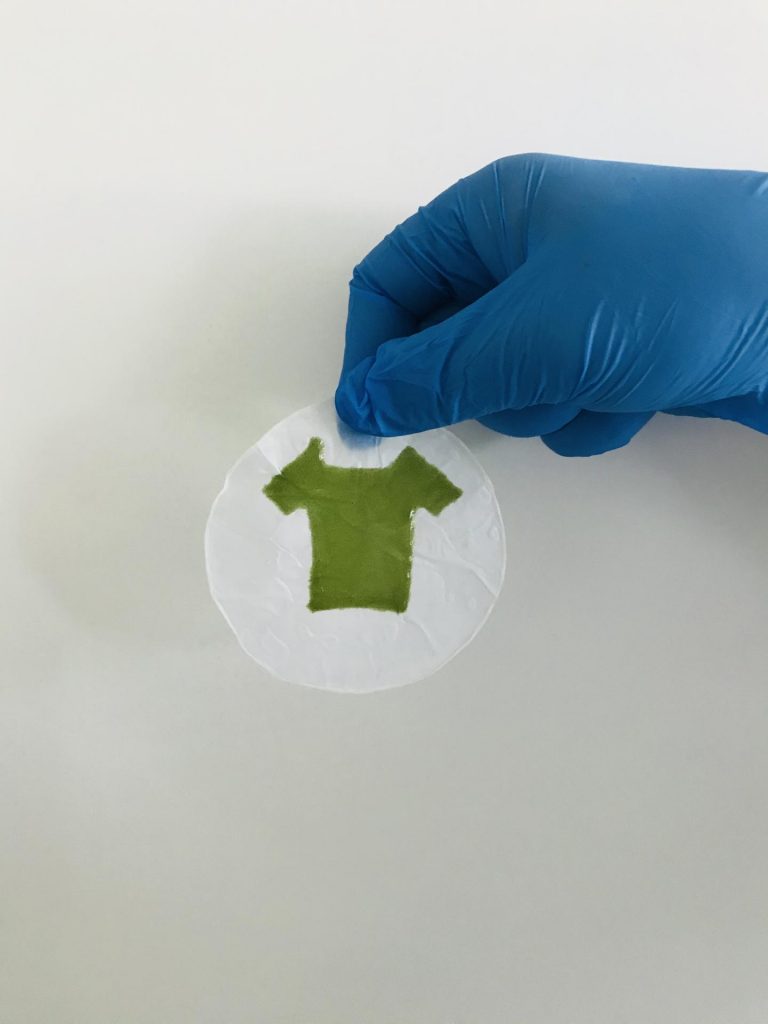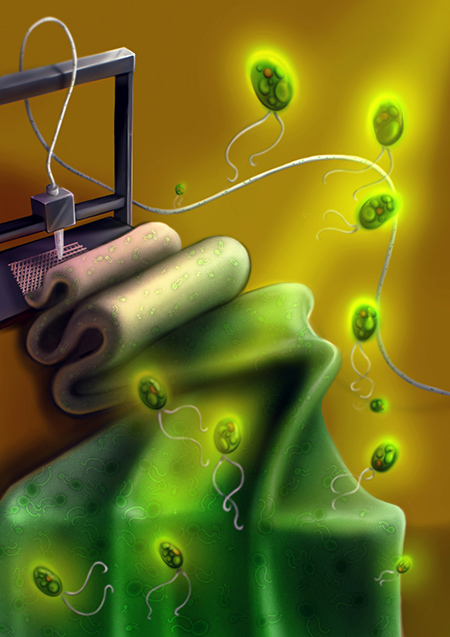
I’m not sure how I feel about a t-shirt, regardless of size, made of living biological material but these researchers seem uniformly enthusiastic. From a May 3, 2021 news item on phys.org (Note: A link has been removed),
Living materials, which are made by housing biological cells within a non-living matrix, have gained popularity in recent years as scientists recognize that often the most robust materials are those that mimic nature.
For the first time, an international team of researchers from the University of Rochester [located in New York state, US] and Delft University of Technology in the Netherlands used 3D printers and a novel bioprinting technique to print algae into living, photosynthetic materials that are tough and resilient. The material has a variety of applications in the energy, medical, and fashion sectors. The research is published in the journal Advanced Functional Materials.
…
An April 30, 2021 University of Rochester new release (also on EurekAlert but published May 3, 2021) by Lindsey Valich, which originated the news item, delves further into the topic of living materials,
“Three-dimensional printing is a powerful technology for fabrication of living functional materials that have a huge potential in a wide range of environmental and human-based applications.” says Srikkanth Balasubramanian, a postdoctoral research associate at Delft and the first author of the paper. “We provide the first example of an engineered photosynthetic material that is physically robust enough to be deployed in real-life applications.”
HOW TO BUILD NEW MATERIALS: LIVING AND NONLIVING COMPONENTS
To create the photosynthetic materials, the researchers began with a non-living bacterial cellulose–an organic compound that is produced and excreted by bacteria. Bacterial cellulose has many unique mechanical properties, including its flexibility, toughness, strength, and ability to retain its shape, even when twisted, crushed, or otherwise physically distorted.
The bacterial cellulose is like the paper in a printer, while living microalgae acts as the ink. The researchers used a 3D printer to deposit living algae onto the bacterial cellulose.
The combination of living (microalgae) and nonliving (bacterial cellulose) components resulted in a unique material that has the photosynthetic quality of the algae and the robustness of the bacterial cellulose; the material is tough and resilient while also eco-friendly, biodegradable, and simple and scalable to produce. The plant-like nature of the material means it can use photosynthesis to “feed” itself over periods of many weeks, and it is also able to be regenerated–a small sample of the material can be grown on-site to make more materials.
ARTIFICIAL LEAVES, PHOTOSYNTHETIC SKINS, AND BIO-GARMENTS
The unique characteristics of the material make it an ideal candidate for a variety of applications, including new products such as artificial leaves, photosynthetic skins, or photosynthetic bio-garments.
Artificial leaves are materials that mimic actual leaves in that they use sunlight to convert water and carbon dioxide–a major driver of climate change–into oxygen and energy, much like leaves during photosynthesis. The leaves store energy in chemical form as sugars, which can then be converted into fuels. Artificial leaves therefore offer a way to produce sustainable energy in places where plants don’t grow well, including outer space colonies. The artificial leaves produced by the researchers at Delft and Rochester are additionally made from eco-friendly materials, in contrast to most artificial leaf technologies currently in production, which are produced using toxic chemical methods.
“For artificial leaves, our materials are like taking the ‘best parts’ of plants–the leaves–which can create sustainable energy, without needing to use resources to produce parts of plants–the stems and the roots–that need resources but don’t produce energy,” says Anne S. Meyer, an associate professor of biology at Rochester. “We are making a material that is only focused on the sustainable production of energy.”
Another application of the material would be photosynthetic skins, which could be used for skin grafts, Meyer says. “The oxygen generated would help to kick-start healing of the damaged area, or it might be able to carry out light-activated wound healing.”
Besides offering sustainable energy and medical treatments, the materials could also change the fashion sector. Bio-garments made from algae would address some of the negative environmental effects of the current textile industry in that they would be high-quality fabrics that would be sustainability produced and completely biodegradable. They would also work to purify the air by removing carbon dioxide through photosynthesis and would not need to be washed as often as conventional garments, reducing water usage.
“Our living materials are promising because they can survive for several days with no water or nutrients access, and the material itself can be used as a seed to grow new living materials,” says Marie-Eve Aubin-Tam, an associate professor of bionanoscience at Delft. “This opens the door to applications in remote areas, even in space, where the material can be seeded on site.”
Here’s a link to and a citation for the paper,
Bioprinting of Regenerative Photosynthetic Living Materials by Srikkanth Balasubramanian, Kui Yu, Anne S. Meyer, Elvin Karana, Marie-Eve Aubin-Tam DOI: https://doi.org/10.1002/adfm.202011162 First published: 29 April 2021
This paper is open access.
The researchers have provided this artistic impression of 3D printing of living (microalgae) and nonliving materials (bacterial cellulose),
